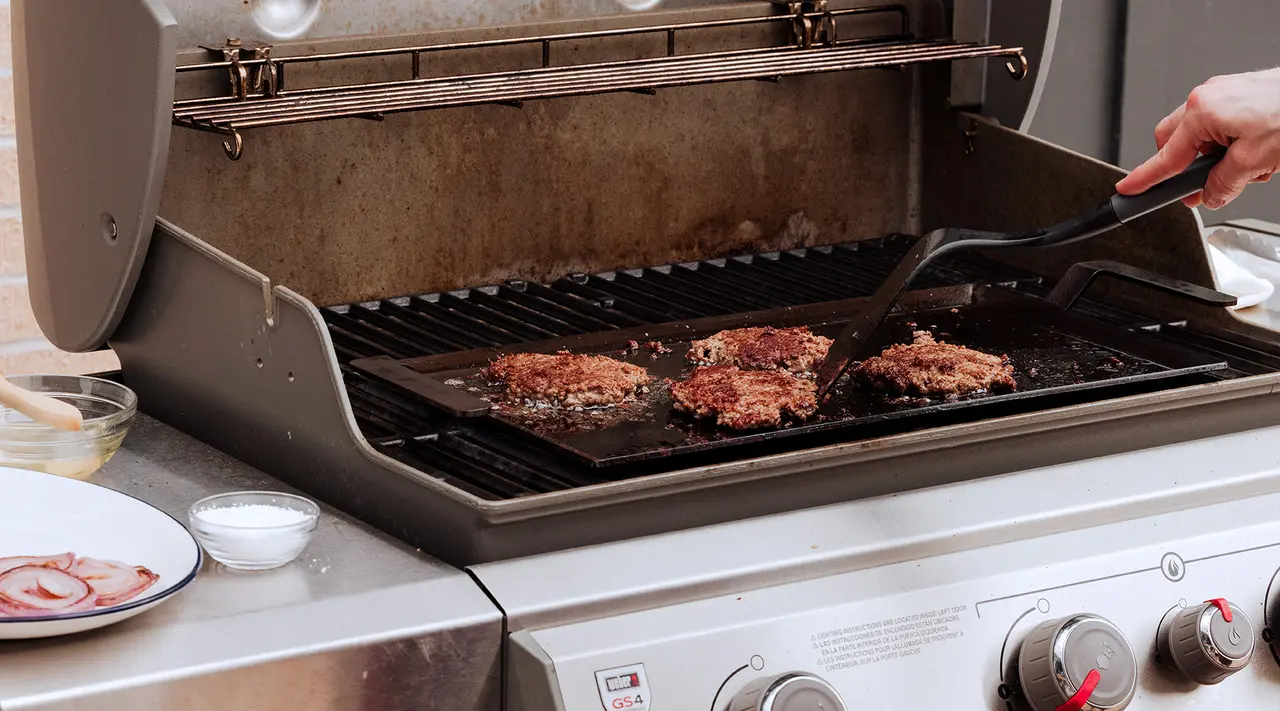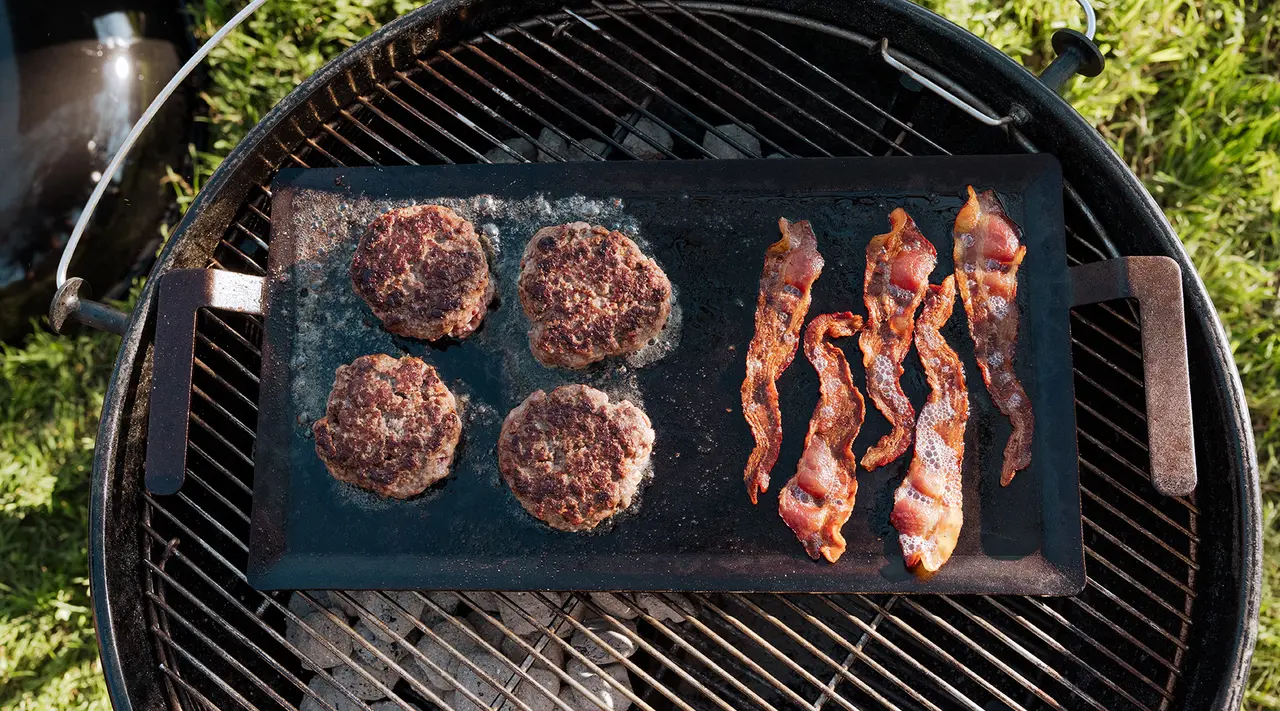Griddles are well-known and loved for their ability to cook a ton of food at the same time, lending steaks, burgers, and even vegetables a beautifully brown crust. The best griddles, therefore, are the ones made of materials like carbon steel or cast iron, both of which retain heat incredibly well: once they get hot, they stay hot—even after you’ve added a whole mess of lamb chops or several whole fish.
While these two materials are similar, however they’re not quite the same: because of how cast iron and carbon steel pans are made, they differ somewhat in terms of weight, non stick capacity, and heat conductivity. To decide which one you should get for your home kitchen, we’ve put together the following guide. Read on to learn some of the advantages—and disadvantages—of each.
Understanding Cast Iron Griddles
Made by pouring molten hot iron alloy into a mold and leaving it to cool, unfinished cast iron is a no-brainer for cooks who want an affordable, long-lasting pan with excellent heat retention. It comes with a few quirks and is a little high maintenance, but once you get the hang of seasoning its versatility knows no bounds.
Now, imagine that same searing power and durability but in the form of a pan with over twice the surface area as your favorite cast iron skillet. That’s what you get with a cast iron griddle, or a long, flat-top style pan that offers tons of cooking surface. In short: the same hardy construction and natural non stick surface, but way more room to cook, flip, and smash your food to perfection.
Advantages
Affordability: Cast iron—especially unfinished cast iron, which is the kind typically used for griddles—is one of the more affordable cookware materials you can purchase. This can be an advantage when purchasing a griddle, as this larger specialty cookware tends to be pricier than standard frying pans. Like carbon steel, seasoned cast iron also offers a non stick surface, making for easier cooking and cleanup.
Durability: Cast iron is known for lasting generations. Not only is it less prone to warping, but the surface is also easy to restore—nine times out of ten, all you need to do is re-season it. Cast iron is also grill safe and induction compatible, making it super versatile as well.
Considerations
Weight: The same sturdy, indestructible build that makes cast iron so great at holding heat can also make for a heavy and unwieldy pan. While this is less of an issue with a skillet or smaller piece of cookware, a griddle’s larger size can make it a bit cumbersome to pick up—doubly so if you plan to use it for outdoor cooking, either over live fire or a grill.
Heat Response: Another disadvantage of using a cast iron griddle is the fact that it’s not as responsive to changes in temperature as carbon steel. This stems from one of its advantages—stellar heat retention—which comes in handy when searing or grilling but makes it difficult to cook foods that are delicate or prone to overcooking, like fish. And because unfinished cast iron tends to heat a bit unevenly compared to other materials, it’s more difficult to achieve dual cooking zones (and thus properly cooked results).
Ingredient Use: Lastly, it’s not recommended to use acidic ingredients like wine, citrus, vinegar, or tomatoes when cooking with cast iron. Not only will this strip the layers of hard-earned seasoning, but the acid will also react with the metal and create unpleasant flavors.
Explaining Carbon Steel Griddles

One of our favorite materials to cook with, carbon steel is prized for its responsiveness to temperature change, smooth matte surface, and lightweight build. Carbon steel is made of a single sheet of metal alloy that’s annealed—or heat-treated—to make it both stronger and easier to shape. This results in a pan that’s somehow both incredibly durable yet impressively light weight—about half the weight of cast iron counterparts.
Like cast iron, carbon steel can handle extreme temperatures: Our carbon steel griddle is heat safe up to 1200F, and was designed to perform anywhere from back burner to backyard to—with the help of the expanded Griddle System—backwoods.
To us, this makes carbon steel the ideal material for a griddle.
Advantages
Heat Response: Because of carbon steel’s responsiveness to temperature, cooks can quickly lower the heat at the exact moment pancakes turn golden brown, or a strip of fatty bacon has rendered to crispy perfection. Since a huge selling point of a griddle is its ability to cook multiple foods at once, a griddle made of carbon steel offers a major advantage in that it can be used to create dual temperature zones on the grill or stove. This allows you to finish foods like meat or fish without overcooking them, and allows you to cook different kinds of ingredients simultaneously.
Weight: At about half the weight of cast iron, carbon steel cookware is our go-to for outdoor cooking situations where every ounce matters. But that’s not the only place it excels—in addition to gas stoves, grills, and campfire pits, carbon steel is also compatible with induction cooktops.
Cooking Surface: Similarly to cast iron, carbon steel also offers a smooth, matte surface that’s naturally non stick—at least once it’s been seasoned. Since our carbon steel griddle comes pre-seasoned, you can use it straight out of the box for flaky fish, tender eggs, and airy-light pancakes with minimal sticking and cleanup. Carbon steel requires a lighter hand with seasoning compared to cast iron, meaning less work for hungry cooks.
Considerations
There are very few disadvantages to cooking with carbon steel, but there are a couple of things to keep in mind.
Reactivity: First, carbon steel—like cast iron—is reactive, meaning that it shouldn’t be used to cook acidic ingredients like vinegar or citrus, as they can strip the seasoning and produce off flavors in your food. If you do cook reactive ingredients with your carbon steel griddle, you'll likely be due for a reseasoning.
Maintenance: Also like cast iron, carbon steel is prone to rusting and corrosion. This can occur due to lack of use or to not properly cleaning and drying your griddle before storing, though it can also happen if you live in a particularly humid area.
Which Makes for the Better Griddle?

Now that you know the key differences between cast iron and carbon steel griddles, it’s time to put them head-to-head.
Heat Retention
Both carbon steel and cast iron griddles offer excellent heat retention, meaning that your food will cook evenly without your having to constantly adjust the temperature. However, cast iron has comparatively poor heat responsiveness and tends to heat less evenly than carbon steel.
Durability
Both carbon steel and cast iron are about on even keel when it comes to durability, though cast iron tends to be a bit more brittle—i.e. prone to cracking or breaking—than carbon steel. And while cast iron can handle higher temperatures, with carbon steel maxing out at about 1200F, we don’t think that’ll be much of an issue.
Weight
Cast iron is quite a bit heavier than carbon steel, with cast iron pans easily weighing twice as much as carbon steel pans of the same size. With a larger piece of cookware like a griddle, this additional weight is even more noticeable.
Maintenance
Both cast iron and carbon steel griddles need to be seasoned before use, and must be hand washed and dried thoroughly before putting away. Both also require periodic reseasoning, and neither should be used to cook acidic ingredients to avoid stripping the seasoning.
Versatility
Cast iron and carbon steel are both extremely versatile, though carbon steel’s superior heat responsiveness is better for cooking a wider variety of meals. Delicate foods like eggs and fish are harder to overcook on carbon steel than on cast iron.
Performance
While both cast iron and carbon steel griddles can make a great addition to your arsenal, carbon steel makes for better control over temperature and the ability to create dual cooking zones for searing and finishing. For us, that makes carbon steel the clear winner.
Ready to Shop?
We think every kitchen can be improved by a griddle. And since we love both cast iron and carbon steel pans for their heat retention and durability, both also work well in griddle form, lending optimal browning and char to all of your favorite meats, seafood, and vegetables. Between the two, however, carbon steel’s optimal cooking performance, lightweight build, and durability make it our hands-down favorite.
























